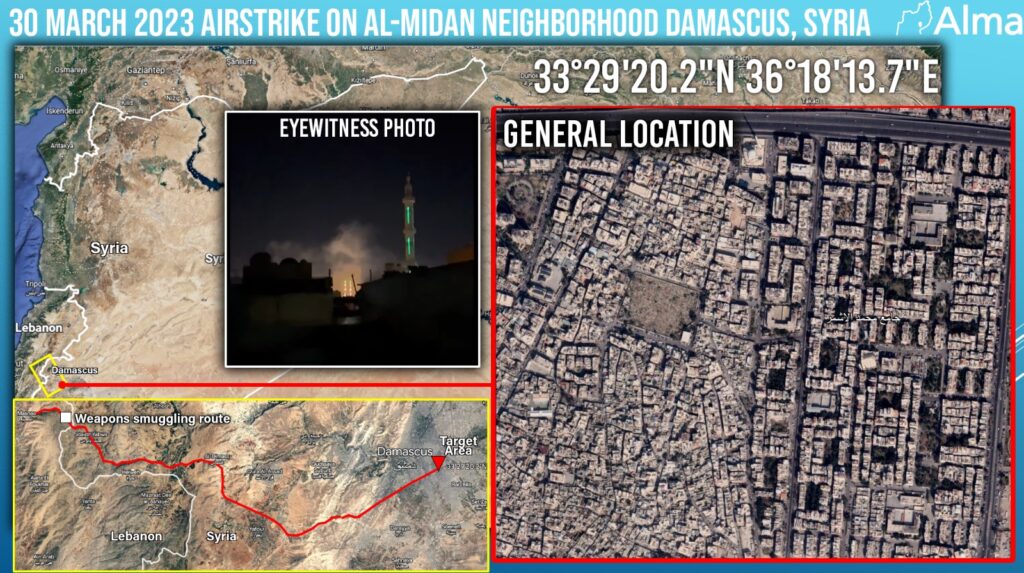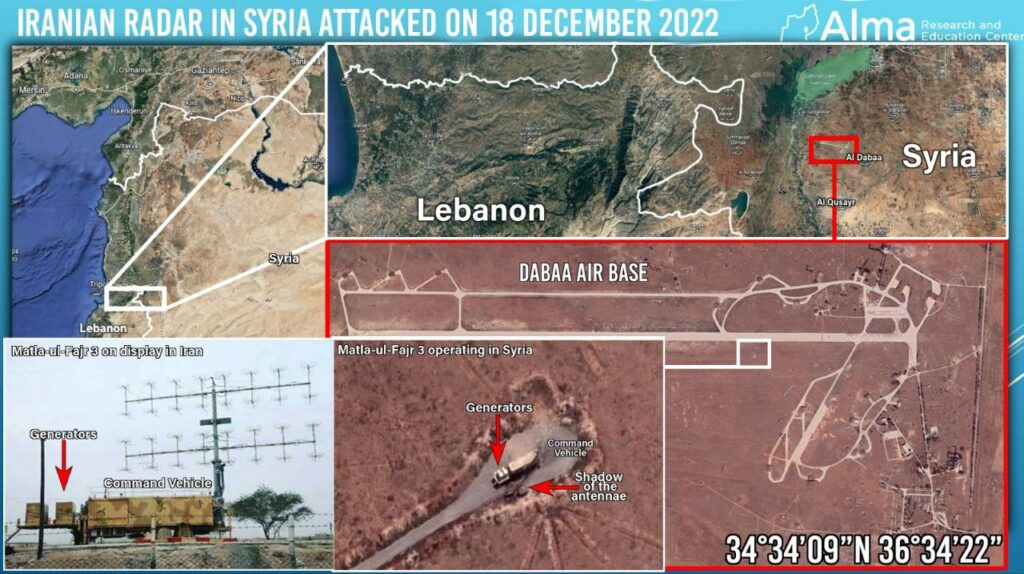General:
For four days (March 30 – April 2, 2023), three airstrikes were carried out against several targets in Damascus and Hom’s areas in northwestern Syria. Most of the targets seemed to be in military environments. At least one target was in civilian surroundings. These areas are distinct areas of the Iranian corridor activity, particularly for Hezbollah. As a result of the attacks, two Iranian IRGC personnel were killed. The Iranians are threatening retaliation.
The Damascus and Homs areas are major geographical anchors in the framework of Iranian activity and the Iranian corridor. For example, these two geographical areas serve as short-term “storage stations” for weapons before they are handed over to Hezbollah in Lebanon and long-term “storage stations” for future use by the Shiite axis in Syria.
The attacks illustrate the “cat and mouse game” played in the attempt to disrupt the activities of the radical Shia axis led by Iran in Syria in general and the Iranian corridor for the transfer of weapons to Syria and Lebanon in particular. In our assessment, the “game” of transferring weapons will intensify in light of the Iranian exploitation of the February 2023 earthquake.
During the airstrikes, the Syrian air defense fired dozens of missiles against the attacking force but was also hit, sustaining damage and losses.


The airstrikes in the Damascus area:
On March 30 and 31, two-night airstrikes were carried out against targets in the Damascus area. The main targets are apparently related to the activity of the Shiite axis (weapons / advanced weapons components/infrastructure), and the secondary targets are Syrian army air defense batteries. In contrast to the first attack (March 30) in the Al-Meidan neighborhood of Damascus, which was a pinpoint attack against a target disguised as a “civilian” infrastructure, the second attack (March 31), in the area of Al-Qassawa-Jarrahleh, south of Damascus, appeared to be a large-scale attack on several military targets.
An Iranian declarative response to the attacks in Damascus was not long in coming (March 31). According to the Iranian response, it was stated, among other things, that Israel is trying to divert attention from its internal crisis. It should be noted that the narrative of this statement is quite predictable…
In addition to the above response, the more significant publications (March 31 and April 02) are by Iranian officials on behalf of the IRGC. According to these reports, as a result of the attack in Damascus (it is not clear on what day), two members of the IRGC were killed. The first casualty was a captain in the Revolutionary Guards named Milad Hidri. The second casualty was Miqdad Mehkani (both of whom were defined by the Iranians as “advisors”). It is unclear whether there are other Iranian casualties. Video images of the grieving Hidri family have already been published in Iran. At this stage, we cannot verify or rule out various reports regarding the specific role of the Iranian casualties (advanced technological weapons/intelligence / cyber).


The attack on March 30 was carried out against a target in the Al-Meidan neighborhood in the heart of Damascus. According to the videos released immediately after the attack, a mosque minaret (illuminated in green) can be seen near the site of the attack.
It is possible that an infrastructure compound or storage of advanced weapons/components was attacked, located in the heart of a civilian environment and near a mosque. If so, it is a classic use of the human shield tactic.

Operationally, and assuming there is a desire to quickly transfer weapons to Hezbollah in Lebanon, rapid access from the Al-Meidan neighborhood to Route 1 leads from Damascus to the west to the border crossings with Lebanon. Some reports described hitting a moving target, i.e., a vehicle. In any case, there is no doubt that this is a focused and precise attack against a target in the heart of a civilian area without causing secondary or collateral damage to civilian infrastructure or population.
It is possible that during this attack, a Syrian air defense base in Jabal Qasiyan was also attacked:

The attack on March 31 in the vicinity of Damascus was apparently carried out south of Damascus in the rural area of Al-Kasawa-Jarahleh. In this area, there are several Syrian Army military sites, some of which have already been attacked due to storing weapons belonging to the Shiite axis. It is known that around these sites, air defense batteries are located in Jabel Al Mania and Jabel Al Mudaiea.

The airstrikes in the area of Homs:
On April 2, another night airstrike was carried out in the Homs area in northwestern Syria. The attack apparently included several military targets known to harbor Hezbollah activity. According to local reports, one of the main targets attacked was the al-Dab’a airport. The al-Dab’a airfield is located about 20 km southwest of Homs and about 10 km north of Al-Qassair (under Hezbollah’s complete control, constituting a major land crossing route of the corridor from Syria to Lebanon).

Al-Dab’a Airport has been attacked in the past. It was attacked on December 18, 2022, due to Hezbollah’s 127th unit activity there. The unit is responsible for the production and development of UAVs. The airfield apparently accommodates the unit’s infrastructure. During the December attack, the hangars in which weapons were stored were damaged. An advanced Iranian radar system, the Matla Al-Fajr, was also hit.

According to other reports, targets were also attacked at the T4 base between Palmyra and Homs and at the Shariat base near Homs. These two sites are known as intermediate stations for storing military equipment and weapons transported to Lebanon.


Summary:
In publications after the attacks, the Iranians vowed that there would be an appropriate response. As far as the Iranians are concerned, the tab is intensifying and growing every day, all in light of the lack of a response with sufficient effect or, alternatively, failed attempts. Repeated attempts by the Iranians to avenge themselves around the world against Israeli and Jewish targets have so far failed. A recent such attempt was uncovered in Greece. Launching suicide drones against merchant ships with any Israeli connection sailing in the Gulf of Oman has not caused sufficient damage or a cognitive effect on their part. All this only increases the Iranians’ frustration and desire for revenge. The options available to the Iranians include direct action against Israeli territory by Iranian forces or by proxy.
In the report in which we summarized and analyzed the activity of the CBW for 2022, we wrote that in our assessment, the earthquake that occurred last February created an operative opportunity for the Iranians. During 2023, it will provide the Iranians with optimal civilian coverage for their military activity in Syria and throughout the corridor.
In light of this, in our assessment, the pace of attacks within the framework of the CBW will continue to increase. These attacks will be carried out following the understanding of the threat arising from transferring advanced weapons to Syria and Hezbollah in Lebanon and, per intelligence, utilizing opportunities to carry out the attacks.






